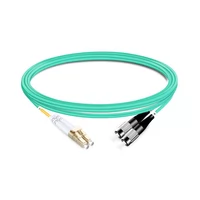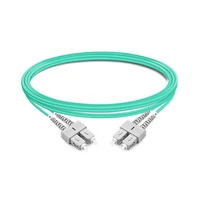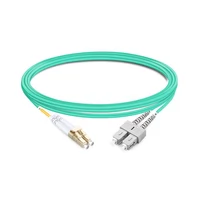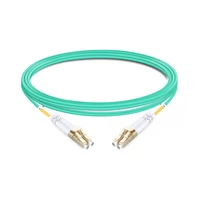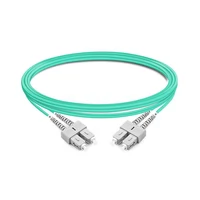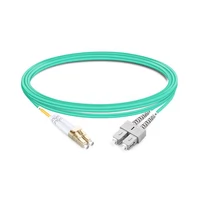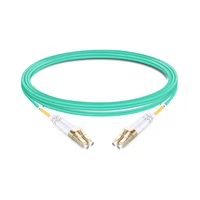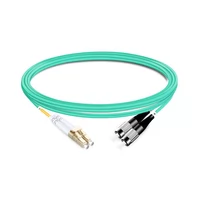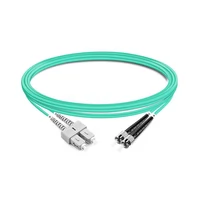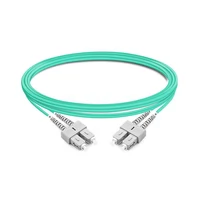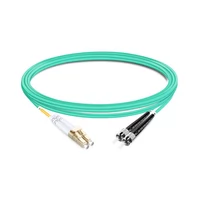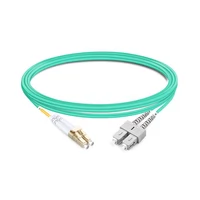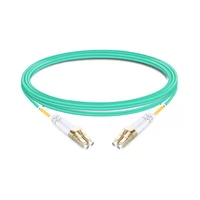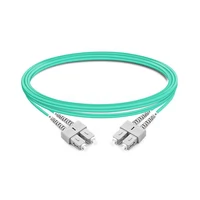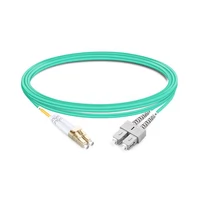Multimode fiber optic cables are essential in modern data communication systems since they can transmit data efficiently and at high speeds over short and medium distances. These fiber cables are structurally designed to transmit several light signals simultaneously, each of which is directed toward the walls of the cable at different angles. Therefore, some of them get accommodated in the walls. The typical construction of multimode fibers is accompanied by increased core size, allowing for transmitting several light modes. These are, however, different from the single-mode fibers, which are meant for long-distance transmissions but only permit one type of light mode. Because of the larger core diameters and intended uses in environments such as data centers, local area networks LANs, and storage area networks SANs, multimode fibers are appreciated for their performance-cost ratio. Therefore, this guide focuses on the technical characteristics, areas of use, and advantages of multimode fiber optic cables to systematically introduce specialists to the network design and implementation process.
Table of Contents
ToggleWhat is a Multimode Fiber Optic Cable?
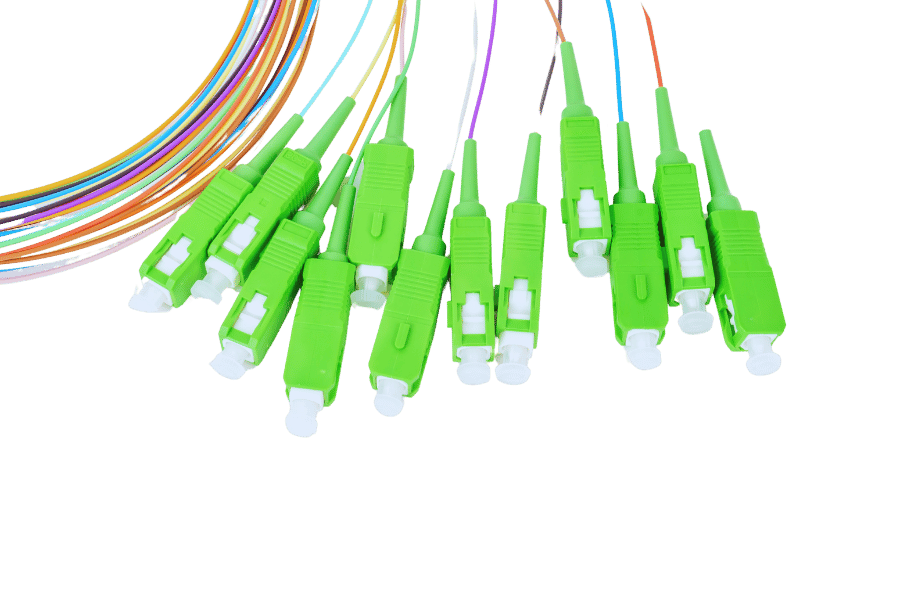
Multimode fiber optic cable is an optical fiber that transmits several light signals simultaneously through short or moderate distances, usually not exceeding several kilometers. This optical fiber generally has bigger core diameters ranging from 50 to 62.5 micrometers, allowing multiple modes of light transmission through the cable. As a result, multimode fibers can be efficiently used for high bandwidth data transfers and economically used in applications like densified deployments in data centers and local area networks (LANS). The design structure facilitates better light coupling, such as that of LEDs and VCSELs, which is also a contributing factor to their applications in many communication systems where distance is not long!
Understanding Fiber Core and Cladding
The center of a multimode fiber optic cable is called the fiber core, where light signals are transmitted. This cavity is filled with a material layer with a lower refractive index to reflect and hold the light in the core. The primary micro-structure character of the fiber core is its diameter, which, in the case of the fibrolite, is 50 or 62.5 microns in diameter. Because of this larger diameter, light propagation in all its modes is now achieved, enhancing its effectiveness in short-hop applications. The typical dimension of the cladding is approximately 125 micrometers in construnctionwiththecore, encouraging data transmission at very high speeds, with little signal loss over long distances. As with other optical fibers, the central core and the surrounding cladding materials, which are mainly made of good materials such as glass or plastic, explain mainly the bandwidth of the fiber and candidate electrical signals.
How Does Core Diameter Affect Performance?
Core geometry, precisely core diameter, is one of the parameters that affect the functional characteristics of multimode fiber optic cables. This type of fiber with a larger diameter allows for the transmission of light in different paths or modes, hence the possibility of inducing modal dispersion. Such dispersion may render it difficult to maintain the I/O signals over long distances, thus limiting bandwidth distance products at higher values of the core diameter. Meanwhile, in such a core as that of single-mode fibers with smaller diameters, light is restricted from following one path, which reduces the dispersion, making it possible to accommodate more bandwidth and longer distances. However, the benefits of larger core diameter in the case spools of the few densities of multimode fiber are that they improve the coupling efficiency to light emitting devices, economizing on the cost incurred in precise alining for shut range applications like data centers. Thus, performance and application environment dictate the core diameter size for every requirement.
Difference Between Single Mode and Multimode Fiber
Single-mode fiber optics and multimode fiber optic cables differ in their core dimensions and the number of light propagation paths they can support. On the one hand, single-mode fibers have a core of smaller diameter, usually 8 to 10 micrometers in diameter, which confines the light being conducted in one longitudinal path or mode. This feature reduces the modal dispersion, which in turn enhances the signal quality over greater distances; hence, its usage is in long-distance telecommunications and high bandwidth networks. However, multimode OM3 fibers possess wider core sizes ranging between 50 to 62.5 micrometers, thus admitting more than one light mode. This leads to modal dispersion, which effectively restricts transmission distance and bandwidth. However, the advantages of the multimode design are that these types of fibers will be less expensive and easier to couple to the light sources making use of the fibers for such short distances as interconnections or within buildings & data centers where costs and use are the primary factors rather than distance/speed.
How to Choose the Right Multimode Fiber for Your Needs?
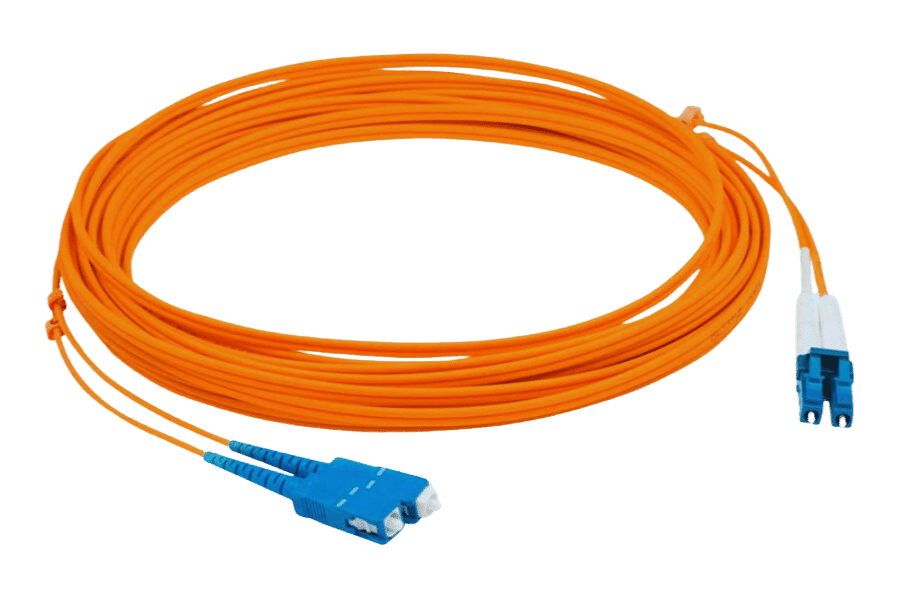
Exploring OM3 and OM4 Fiber Options
When acquiring a multimode fiber, specifically OM3 or OM4, the primary implications are the required bandwidth and transmission convergence of the given network. OM3 fiber was made resilient to support 10 Gigabit Ethernet even for 300 meters, which usually accommodates most data center and enterprise network applications. Its core is designed for laser light and is cheaper for medium-range connectivity. On the other hand, the fiber OM4 can extend its reach by improving a 10 Gigabit Ethernet to 550 meters and even supporting the 100 Gigabit Ethernet at a more optimal distance. Therefore, the fiber OM4 filter is the most suitable where high performance is expected in terms of making reaches required in most large data centers with high traffic or campus networks. Therefore, using the different standards should be strictly based on the link’s cost, distance, and bandwidth on a fragile balance.
Importance of Wavelength in Fiber Selection
The wavelength is a critical factor that contributes to the quality and efficiency of the fiber optic communication system. Variations in these different wavelengths may help impact the attenuation and dispersion properties of optical fibers, affecting the data quality. In multimode fibers, the most common operating wavelengths are 850 nm and 1300 nm, where the former is mainly used for OM3 and OM4 multimode fiber because it is ideal for high-temperature laser applications with high data rates. Reducing attenuation decided by the wavelength selection also enhances bandwidth, high-quality data transmission over a specified distance, and a reduction in dispersion. Therefore, effective network performance and service provisioning can only be attainable when the wavelength in use has been carefully established.
Considerations for Laser-Optimized Cables
In analyzing laser-optimized cables, the buyer has to consider certain aspects that could be essential in maximizing the network performance while cutting costs. To begin, examine the application’s bandwidth requirement and the transmission distance to define the type of cable—OM3 or OM4—that fits the performance requirements. Sufficient analysis actions should be carried out before choosing cable so that the objectives, such as whether it is for 10 Gigabit Ethernet data rates or higher architected networks, are satisfactorily met. Next, it is also wise to consider the expansion in the future; this pertains to the necessity of choosing a cable with a greater bandwidth on the assumption that it would save future expenses in the erection of the network. After that, ensure that the cable is compatible with other network parts, such as transceivers that have been previously utilized, to avoid interoperability problems. Finally, specific conditions need to be considered, such as the environment in which the cable is used and the geographical barriers present while installing it. These would enhance the network systems’ utility, performance, and durability if considered.
What Are the Key Connectors for Multimode Fiber Optic Cables?
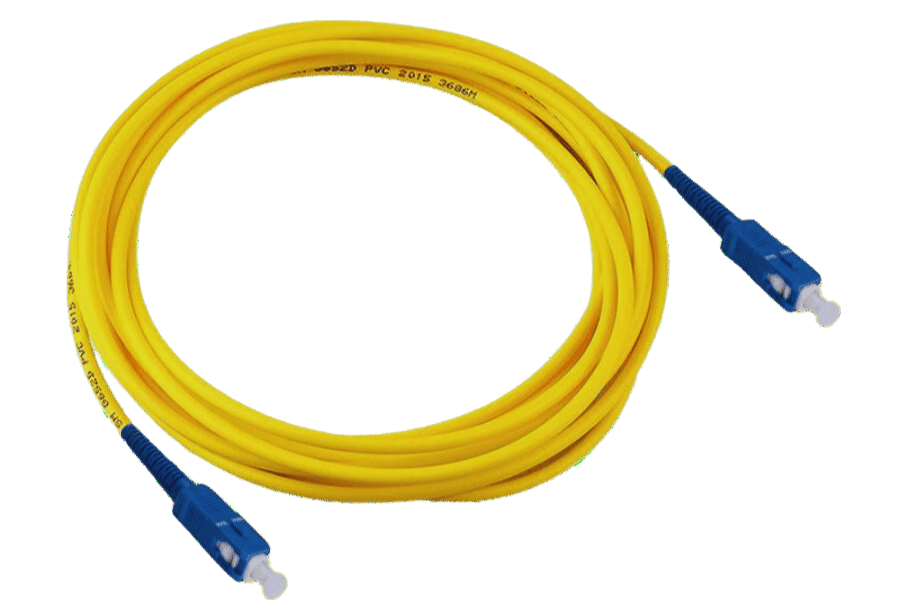
Benefits of Using LC Connectors
Due to their small size and efficiency, LC connectors have become a choice of many in fiber optic networks. One key advantage is their small form factor, which is less than half that of SC connectors, and hence minimizes space consumption in dense network configurations. This situation makes LC connectors especially beneficial in knowledge and enterprise centers and telecommunications environments with limited space. LC connectors also have a push-pull latching system that makes strong connections that fuse two LC connectors, reducing the insertion loss and thus maximizing the network’s operational efficiency.
From technical parameters, the typical parameter of LC plug connectors is the insertion loss measure, which is always less than 0.3dB, diminishing signal over the journey. Depending on the application, they fit different multimode and singlemode fibers, increasing their usage. In addition, the design of the connectors employs features that allow the transmission of high-speed data rates, which is compatible with 10 Gigabit Ethernet and Fibre Channel and the like. The LC connector’s reliability and versatility of application have made this connector popular in support of high-performance and high-capacity fiber optic networks.
How to Select the Right Connector Type?
As with any other type of electrical component, choosing the right type of connector for multimode fiber optic cables is a complex issue due to various technical and situational issues in the interest of maximized operational efficiency at minimal costs. Here’s a brief breakdown based on some of the best sources in the market:
- Suitability with Fiber Type and Usage: Understanding that the type of connector should be compatible with the mode of the fiber optic cable, single mode, dual, or multi-fiber cables, as well as the application requirements. LC and SC connectors would be used in the case of the multimode networks. In contrast, LC and SC connectors would be employed more because of their small size and dependability.
- Insertion Loss and Return Loss: Assess the characteristics of the intended connectors in relation to their effects on the quality of the signal or Optical Return Loss, including, but not limited to, low Insertion Loss and high Return Loss. An LC connector, for instance, has insertion loss values usually less than 0.3 dB while the return loss is above 45 dB, thus propagating high-end networks.
- Environmental and Mechanical Considerations: Review operating ecological conditions, including temperature and humidity levels and mechanical strength required for the mounting environment. Some outdoor multimode fiber optic connectors incorporate rugged versions for more demanding environments. Furthermore, if there are concealment blockers, then the candela cut-out must be made within the propensities regardless and include allowance for future network infrastructure development.
- Ease of Installation and Maintenance: Note the difficulty of installation and maintenance. For instance, LC connectors with a simple push-pull mechanism may be used, as they have a reasonably straightforward termination, attempting to avoid defects while honoring the installation and maintenance stretches.
Verify these parameters by visiting reputable sites and analyzing datasheets from different manufacturers to ensure the selected connector will efficiently serve both present and future network requirements.
Installation Tips for Fiber Patch Cable
Some tips can be applied to enhance the functionality and durability of fiber patch cords. The following guidelines are of utmost importance:
- Verify the Cable Type and Connector Compatibility: Confirm that the fiber patch cable type, such as single mode or multimode, is consistent with the network design, and casing connectors must suit the existing ports, whether an LC or SC is available.
- Keep the Bend Radius Violation to the Least: Adhering to the cable’s minimum bend radius is essential to avoid microscopic bends and, consequently, propagation losses. Default hyperbolas should not be less than ten times the diameter of the cable.
- Incorporate Cable Management Measures: Use appropriate components, such as patch panels and racks, to help organize connector wires and reduce the risk of tangling or damage. These systems should also be such that patient wires and cables are easily accessible for maintenance purposes without adversely affecting performance.
- Ensure Cleanliness of the Connectors in Frequent Intervals: To ensure optimal signal transmission, connectors should be cleaned before installation and periodically during operation. The end faces of the connectors should be cleaned with isopropyl alcohol or fiber optic cleaning kits.
- Do Not Over-Tighten: Take care not to pull the cables during installation to avoid overstretching the fibers. The specifications for pull strength should, in most cases, not exceed fifty N (11.24 lbs).
- Carry Out Tests After The Installation: The cable performance and the cable itself will be diagnosed after installation using OTDR and insertion loss testing techniques.
These tips also correspond to technical requirements from leading industry players regarding following manufacturer requirements and usual practices to ensure efficient network performance.
How to Install and Optimize Your Multimode Fiber Network?
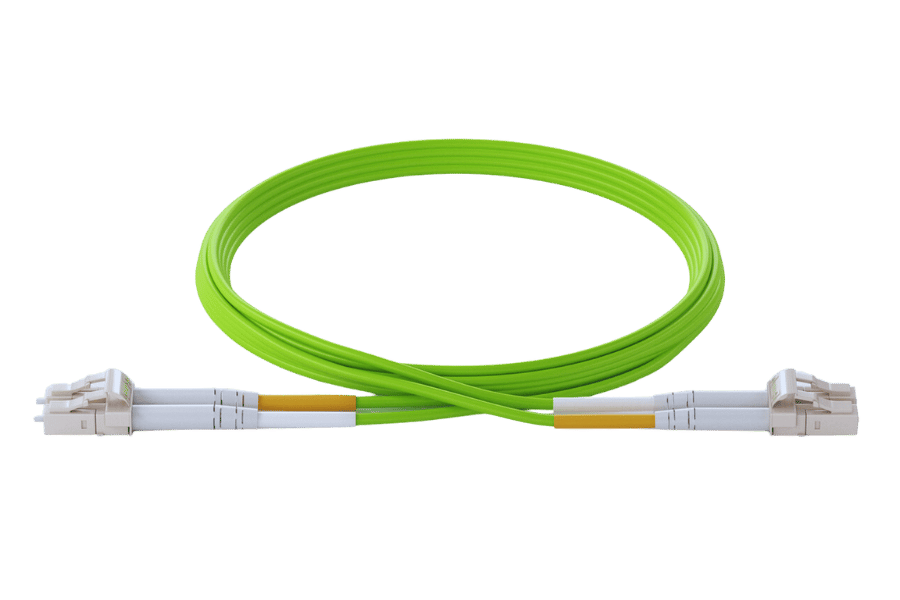
Steps for Installing Multimode Fiber Optic Cables
- Plan Your Layout Review the layout and try to identify the optimal routes of the fiber cable, minimizing risks and overloading any existing systems.
- Measure and Cut Cable Lengths: Precisely record the undue lengths required to tackle several internal or external loops, to be used at terminations. Employ cutting tools whose sizes are standard to the patch cords to cut the fiber optic patch cables.
- Prepare the Installation Environment: Check that the condition meets the standards, is temperature-controlled, and is clean to avoid any form of installation contamination or destruction.
- Pull the Cables through Ducts: Using the cable-pulling lubricant, combine the fish tape at the conduit’s entry to feed the cables slowly and with minimal strain, paying equal attention to the bend radius.
- Terminate with Suitable Connectors: Fit high-quality connectors for multimode fibers and laminate within the correct alignment to achieve high performance.
- Test for Continuity and Quality of the fiber cable connections.: Conduct OTDR and IL tests to ascertain the installation and fiber link quality requirements.
- Document Installation: Provide details cited in the installation such as cable paths, cable feather cuts co-ordinates and measurement test results for reference and upkeep.
Optimizing Performance with Proper Core Size
Core size is one of the key parameters of a multimode fiber network in terms of its performance optimization. Core size, being either 50 micrometers or 62.5 micrometers, primarily determines the data capacity and distance that can be covered. If higher data rates and longer distances are desired, then a 50-micrometer core and laser-optimized multimode fibers (OM3 or OM4) are recommended. These fibers have higher bandwidth and are also used with fast data networks of today’s world. Careful attention is given to determining the correct core size in order to optimize network operation while preventing problems such as dispersion and attenuation along the fiber path. Keep in mind, however, that the core application should be in harmony with the size as determined by industrial practice and the scope of the manufacturers.
Maintaining Your Outdoor Multimode Fiber Optic Cable
If the outdoor multimode fiber optic cables must be used for an extended period, then proper maintenance is very important. One must also perform periodic visual checks for physical damage, which can be dirt, cracks, and abrasion because of exposure to weather. Always ensure that all the connections, heads, and coolers are fixed and closed properly so that moisture doesn’t enter because dampness decreases the signal transmission quality of the system. Performing Periodic maintenance using specialized connectors is very important so that connectivity reliability is improved and signal loss is avoided. A properly written program, especially for network maintenance where an optical time domain reflectometer (OTDR) will often be used to conduct regular evaluations of the network, can help to ensure that potential risks will be addressed before turning into major problems in the network. As a general rule of thumb, all users should follow all the maintenance instructions provided by the manufacturer and that of the industry to avoid making the fiber optic environment more susceptible.
Why Choose OM4 Multimode Fiber for 100G Applications?
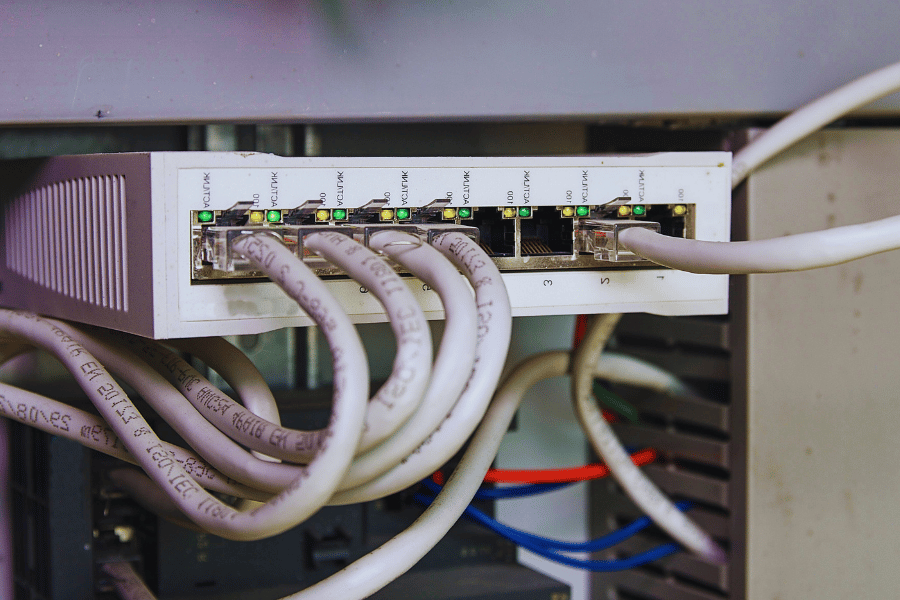
Advantages of OM4 Fiber for High-Speed Networks
For high-speed networks, especially for 100G applications, OM4 fiber has many notable benefits. One, OM4 fiber increases bandwidth ability, offering more than three times the application of OM3 fibers. This enhancement is good for several data-oriented procedures and grows effectively about network requirements. Two, OM4 has a more extended reach and can support up to 550 meters at 10Gb/d, while two large data centers and enterprises require this. In addition, OM4 fiber is less expensive, and the threat to other options, such as single-mode fibers, is reduced, meaning the capex and the opex are low. It’s greater than or equal to its performance concerning attenuation and modal dispersion, making sure that there is signal integrity as well as the network.
How Does Cladding Diameter Impact Data Transmission?
The role of the cladding diameter cannot be overemphasized concerning the behavior of light in the fiber since it influences light confinement within the fiber core diameter. With a uniform cladding dimension, the incidence of such losses is reduced when the light signals are transmitted in the fiber. If there is a variance in the cladding diameter, more internal reflections and attenuation may spoil the communicated data and its speed. The cladding diameters, standardized at around 125 micrometers for every fiber, make it suitable for different types of connectors and splicing machines, thus enhancing the interconnectivity of modular network systems. Adherence to the correct cladding diameter improves the modal dispersion effect, enhancing the entire network’s performance.
Future-Proofing with 100G Technology
In this regard, 100G technology can be applied in network infrastructure hardware for connecting future broadband habits realities. At present, the main areas of advancement in 100G networks are the increase of the parameters of used bandwidth and the decrease in latency, which makes these networks efficient in the real-time processing of big data, especially with the usage of 1550 nm wavelength. This device employs DWDM technology for efficiency even as the signals travel long distances to mitigate distortion and loss of the signals. It has improved scalability and allows integration into existing network environments without immediate radical changes to the infrastructure. Further, the advanced enhancements in error correction and energy consumption of the 100G technology transform its cost characteristics and provide a new means for data centers and corporations to prosper in current developments.
Reference Sources
Frequently Asked Questions (FAQs)
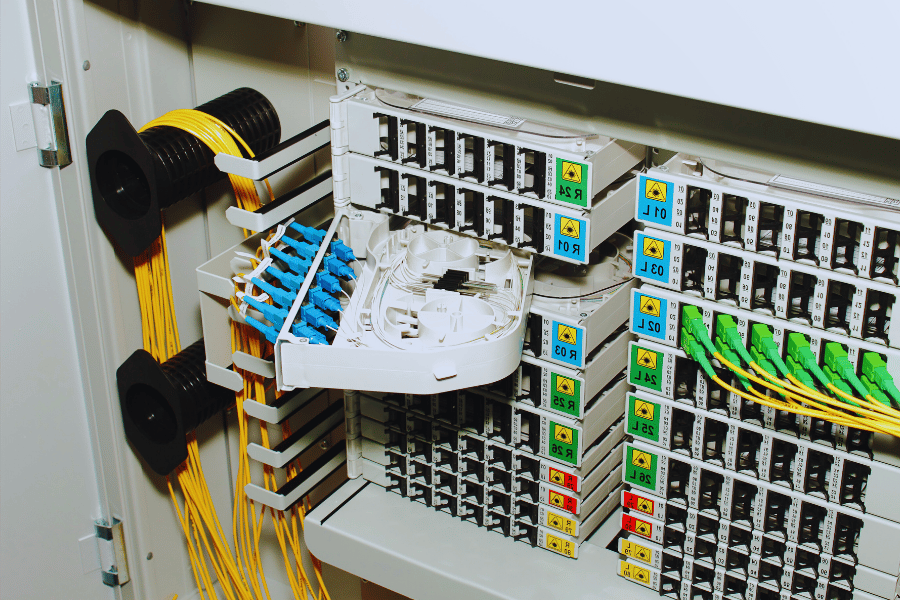
Q: Explain in detail what a multimode fiber optic cable is and how the individuality of a single-mode cable is reflected in it.
A: In telecommunications and computing, distinguished in terms of operating length, a multimode fiber optic cable is a kind of optical fiber with a large core diameter axial capable of transmitting more than one light ray. For this reason, usually, at the core, there are more than 50 or 62.5 microns. It also makes it possible to use cheaper LED components. Single-core fiber is modest in diameter and is fitted to support only a single mode of light and no more. As Such, It Is Saved For Longer Distances And More Bandwidth.
Q: What are the benefits of multimode fiber optic cables?
A: At the same time, the same multimode fiber optic cable still has inevitable advantages for short-distance applications, including cost and ease of installation and termination, due to its larger core and wider range of cheap optical components. This is most applicable in Local Area Networks (LANs) And Data Centers, where distances are usually less than 300 meters.
Q: What makes OM3 different from OM4 multimode fiber?
A: OM3 and OM4 determine a couple of grades of the employment type of multimode optical fiber, which possesses the capacity of high-speed data laser transmission. OM4 is, therefore, a better and higher-quality improvement of OM3 with more bandwidth and longer distances. For example, at 10bps, the maximum coverage distance of OM3 is 300 meters, but the Maximum coverage distance of OM4 is 550 meters. Also, with OM4, it will be easier to upgrade to 40G and 100G Ethernet data rates in the future.
Q: What is the meaning of riser-rated fiber optic cable?
A: Riser-rated fiber optic cable is meant for fiber optic cables that run vertically between the floors of a building in areas that are not plenums. It has a special jacket that is not only fire retardant but also more smoke-free than ordinary cables. Such a rating also ensures that the cable is safe for vertical installation where building codes apply, hence appropriate for risers or for use in elevator shafts.
Q: What is the connection between corn and the fiber optic cables?
A: Although “corn” doesn’t specifically relate to fiber optic cables, you seem to mean Corning fiber in this case. Corning is an essential producer of optical fiber and cables. They manufacture fibers of different kinds, IV, II, snap, etc., all of which are very effective and efficient in the field of telecommunication and data networking.
Q: What is a duplex multimode fiber patch cord?
A: The duplex multimode fiber patch cord can be called a fiber optic patch cord, consisting of a fiber optic cable jacket with two multimode fibers enclosed. It’s most often utilized for two-way transfer, where a single-mode fiber is used to send out information, and one more is used to take the incoming one. Such patch cords find applications in data centers and enterprise networks for interconnecting devices like switches, routers, and servers to the fiber optic network.
Q: How do I choose between multimode and single-mode fiber for my network?
A: Some considerations must determine whether to go for multimode or single-mode fiber. This may include the distance and bandwidth requirements and the economic factors. Multimode fiber is cheaper over short distances (around 500 meters) or less often found in enterprise networks and data centers. Single-mode fiber has more advantages when it comes to long distance, more bandwidth, and future readiness, but this, on the other hand, bears a higher price tag with initial investment because of expensive light-source attachments. This decision should be based on your current network and what you foresee in the future.
Q: I would like to know which fiber connectors are most frequently employed and compatible with multimode fiber.
A: Common fiber connectors used with Multimode Fiber include LC connector( Lucent Connector), Subscriber connector( SC), Straight Tip (ST), and Multi-fiber push-On (MPO). This is a widespread scenario in which LC butt connectors are employed on a data center hub due to their smaller size and ability to mate with high-density optical fiber drawer patch panels. The type of connector18 one uses will likely determine the choice of equipment one connects to and the needs of the network infrastructure.
Related Products:
-
 1m (3ft) Duplex OM3 Multimode LC UPC to FC UPC PVC (OFNR) Fiber Optic Cable
$2.80
1m (3ft) Duplex OM3 Multimode LC UPC to FC UPC PVC (OFNR) Fiber Optic Cable
$2.80
-
 1m (3ft) Duplex OM3 Multimode SC UPC to SC UPC OFNP Fiber Optic Cable
$3.00
1m (3ft) Duplex OM3 Multimode SC UPC to SC UPC OFNP Fiber Optic Cable
$3.00
-
 1m (3ft) Duplex OM3 Multimode LC UPC to SC UPC OFNP Fiber Optic Cable
$3.00
1m (3ft) Duplex OM3 Multimode LC UPC to SC UPC OFNP Fiber Optic Cable
$3.00
-
 1m (3ft) Duplex OM3 Multimode LC UPC to LC UPC OFNP Fiber Optic Cable
$3.00
1m (3ft) Duplex OM3 Multimode LC UPC to LC UPC OFNP Fiber Optic Cable
$3.00
-
 1m (3ft) Duplex OM3 Multimode SC UPC to SC UPC LSZH Fiber Optic Cable
$3.00
1m (3ft) Duplex OM3 Multimode SC UPC to SC UPC LSZH Fiber Optic Cable
$3.00
-
 1m (3ft) Duplex OM3 Multimode LC UPC to SC UPC LSZH Fiber Optic Cable
$3.00
1m (3ft) Duplex OM3 Multimode LC UPC to SC UPC LSZH Fiber Optic Cable
$3.00
-
 1m (3ft) Duplex OM3 Multimode LC UPC to LC UPC LSZH Fiber Optic Cable
$3.00
1m (3ft) Duplex OM3 Multimode LC UPC to LC UPC LSZH Fiber Optic Cable
$3.00
-
 1m (3ft) Duplex OM3 Multimode SC UPC to SC UPC PVC (OFNR) Fiber Optic Cable
$3.00
1m (3ft) Duplex OM3 Multimode SC UPC to SC UPC PVC (OFNR) Fiber Optic Cable
$3.00
-
 1m (3ft) Duplex OM4 Multimode LC UPC to FC UPC PVC (OFNR) Fiber Optic Cable
$2.90
1m (3ft) Duplex OM4 Multimode LC UPC to FC UPC PVC (OFNR) Fiber Optic Cable
$2.90
-
 1m (3ft) Duplex OM4 Multimode SC UPC to ST UPC PVC (OFNR) Fiber Optic Cable
$3.00
1m (3ft) Duplex OM4 Multimode SC UPC to ST UPC PVC (OFNR) Fiber Optic Cable
$3.00
-
 1m (3ft) Duplex OM4 Multimode SC UPC to SC UPC PVC (OFNR) Fiber Optic Cable
$3.00
1m (3ft) Duplex OM4 Multimode SC UPC to SC UPC PVC (OFNR) Fiber Optic Cable
$3.00
-
 1m (3ft) Duplex OM4 Multimode LC UPC to ST UPC PVC (OFNR) Fiber Optic Cable
$3.00
1m (3ft) Duplex OM4 Multimode LC UPC to ST UPC PVC (OFNR) Fiber Optic Cable
$3.00
-
 1m (3ft) Duplex OM4 Multimode LC UPC to SC UPC PVC (OFNR) Fiber Optic Cable
$3.00
1m (3ft) Duplex OM4 Multimode LC UPC to SC UPC PVC (OFNR) Fiber Optic Cable
$3.00
-
 1m (3ft) Duplex OM4 Multimode LC UPC to LC UPC PVC (OFNR) Fiber Optic Cable
$3.00
1m (3ft) Duplex OM4 Multimode LC UPC to LC UPC PVC (OFNR) Fiber Optic Cable
$3.00
-
 1m (3ft) Duplex OM4 Multimode SC UPC to SC UPC OFNP Fiber Optic Cable
$3.10
1m (3ft) Duplex OM4 Multimode SC UPC to SC UPC OFNP Fiber Optic Cable
$3.10
-
 1m (3ft) Duplex OM4 Multimode LC UPC to SC UPC OFNP Fiber Optic Cable
$3.10
1m (3ft) Duplex OM4 Multimode LC UPC to SC UPC OFNP Fiber Optic Cable
$3.10

